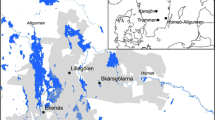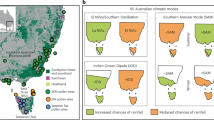Abstract
To assess quantitatively the age of the modern vegetated landscape of Europe and western Asia Minor, and to reconstruct Holocene dynamics in biomes and landscape openness, we convert pollen data into plant functional type (PFT) assemblages and interpolate the data in space and time with a 4D thin plate spline. We then assess overall vegetation change using the squared chord distance metric, changes in potential natural vegetation using the biomisation method, and changes in landscape openness by calculating the arboreal pollen PFT percentage. The age of the modern European vegetated landscape varies in space; while much of lowland Europe dates to ~2,000 cal years bp, some areas have remained unchanged since the beginning of the Holocene; on average, the European vegetated landscape is ~4,000 years old. Though the (PFT) assemblage became continuously more similar to present, biome assemblages changed in northern and southern Europe but stayed relatively constant in central Europe. Landscape openness as approximated by arboreal PFT % increased until the mid-Holocene and then returned to early-Holocene conditions by modern times. The temporally continuous dominance of forest biomes suggests climate remained favourable to forest cover across Europe throughout the Holocene. Nevertheless, arboreal PFT % decreased significantly between the mid-Holocene and the present, requiring a non-climatic explanation, which can be offered by disturbance from human activity. Thus, human activity may have been a main driver of European vegetation dynamics since the mid-Holocene, suggesting it should be included in future conceptions of “natural” European vegetation dynamics.









Similar content being viewed by others
References
Andric M, Willis KJ (2003) The phytogeographical regions of Slovenia: a consequence of natural environmental variation or prehistoric human activity? J Ecol 91:807–821
Behre K-E (1988) The rôle of man in European vegetation history. Handb Veg Sci 7:633–672
Birks HJB (2005) Mind the gap: how open were European primeval forests? Trends Ecol Evol 20:154–156
Birks HJB (2012) Ecological palaeoecology and conservation biology: controversies, challenges, and compromises. Int J Biodivers Sci Ecosyst Serv Manag 8:292–304
Bradshaw RHW (2004) Past anthropogenic influence on European forests and some possible genetic consequences. For Ecol Manage 197:203–212
Bradshaw RHW, Hannon GE, Lister AM (2003) A long-term perspective on ungulate-vegetation interactions. For Ecol Manag 181:267–280
Carrión JS (2010) The concepts of potential natural vegetation (PNV) and other abstractions (trying to pick up fish with wet hands). J Biogeogr 37:2,209–2,215
Carrión JS, Fernández S (2009) The survival of the ‘natural potential vegetation’ concept (or the power of tradition). J Biogeogr 36:2,202–2,203
Cheddadi R, Bar-Hen A (2009) Spatial gradient of temperature and potential vegetation feedback across Europe during the late Quaternary. Clim Dyn 32:371–379
Collins PM, Davis BAS, Kaplan JO (2012) The mid-Holocene vegetation of the Mediterranean region and southern Europe, and comparison with the present day. J Biogeogr 39:1,848–1,861
Davis BAS, Brewer S, Stevenson AC, Guiot J, Data Contributors (2003) The temperature of Europe during the Holocene reconstructed from pollen data. Quat Sci Rev 22:1,701–1,716
De Beaulieu J-L, Miras Y, Andrieu-Ponel V, Guiter F (2005) Vegetation dynamics in north-western Mediterranean regions: instability of the Mediterranean bioclimate. Plant Biosyst 139:114–126
Dermody BJ, De Boer HJ, Bierkens MFP, Weber SL, Wassen MJ, Dekker SC (2012) A seesaw in Mediterranean precipitation during the Roman Period linked to millennial-scale changes in the North Atlantic. Clim Past 8:637–651
Ellenberg H (1988) Vegetation ecology of central Europe. Cambridge University Press, Cambridge
Farris E, Filibeck G, Marignani M, Rosati L (2010) The power of potential natural vegetation (and of spatial-temporal scale): a response to Carrión and Fernández (2009). J Biogeogr 37:2,209–2,215
Fields Development Team (2006) Tools for spatial data. National Center for Atmospheric Research, Boulder, CO. http://www.image.ucar.edu/Software/Fields. Accessed June 2012
Gachet S, Brewer S, Cheddadi R, Davis B, Gritti E, Guiot J (2003) A probabilistic approach to the use of pollen indicators for plant attributes and biomes: an application to European vegetation at 0 and 6 ka. Glob Ecol Biogeogr 12:103–118
Gaillard M-J, Sugita S, Macier F et al (2010) Holocene land-cover reconstructions for studies on land cover-climate feedbacks. Clim Past 6:483–499
Gajewski K, Viau AE, Sawada M, Atkinson DE, Fines P (2006) Synchronicity in climate and vegetation transitions between Europe and North America during the Holocene. Clim Chang 78:341–361
Gallimore R, Jacob R, Kutzbach J (2005) Coupled atmosphere-ocean-vegetation simulations for modern and mid-Holocene climates: role of extratropical vegetation cover feedbacks. Clim Dyn 25:755–776
Gavin DG, Oswald WW, Wahl ER, Williams JW (2003) A statistical approach to evaluating distance metrics and analog assignments for pollen records. Quat Res 60:356–367
Giesecke T, Bennett KD (2004) The Holocene spread of Picea abies (L.) Karst. in Fennoscandia and adjacent areas. J Biogeogr 31:1,523–1,548
Giesecke T, Hickler T, Kunkel T, Sykes MT, Bradshaw RH (2007) Towards an understanding of the Holocene distribution of Fagus sylvatica L. J Biogeogr 34:118–131
Giesecke T, Wolters S, Jahns S, Brande A (2012) Exploring Holocene changes in palynological richness in Northern Europe—did postglacial immigration matter? PLOSone 7:1–11
Gliemeroth AK (1997) Paläoökologische Aspekte der Einwanderungsgeschichte einiger Baumgattungen während des Holozäns nach Europa. Angewandte Botanik 71:54–61
Gritti ES, Gachet S, Sykes MT, Guiot J (2004) An extended probabilistic approach of plant vital attributes: an application to European pollen records at 0 and 6 ka. Glob Ecol Biogeogr 13:519–533
Grove AT, Rackham O (2003) The nature of Mediterranean Europe: An ecological history. Yale University Press, New Haven
Guiot J, Cheddadi R, Prentice IC, Jolly D (1996) A method of biome and land surface mapping from pollen data: application to Europe 6,000 years ago. Palaeoclimates 1:311–324
Harding AF (2000) European societies in the Bronze Age. Cambridge University Press, Cambridge
Harrison SP, Digerfeldt G (1993) European lakes as palaeohydrological and palaeoclimatic indicators. Quat Sci Rev 12:233–248
Huntley B (1990a) European post-glacial forests: compositional changes in response to climatic change. J Veget Sci 1:507–518
Huntley B (1990b) Dissimilarity mapping between fossil and contemporary pollen spectra in Europe for the past 13,000 years. Quat Res 33:360–376
Huntley B (1990c) European vegetation history: palaeovegetation maps from pollen data—13,000 years BP to present. J Quat Sci 5:103–122
Huntley B, Birks HJB (1983) An atlas of past and present maps for Europe: 0–13,000 years ago. Cambridge University Press, Cambridge
Jalas J, Suominen J (1972–1999) Atlas Florae Europaeae: distribution of vascular plants in Europe. The committee for mapping the flora of Europe and Societas Biologica Fennica Vanamo, Helsinki
Jalut G, Dedoubat JJ, Fontugne M, Otto T (2009) Holocene circum-Mediterranean vegetation changes: climate forcing and human impact. Quat Int 200:4–18
Kaplan JO, Krumhardt KM, Zimmermann N (2009) The prehistoric and preindustrial deforestation of Europe. Quat Sci Rev 28:3,016–3,034
Kaplan JO, Krumhardt KM, Ellis EC, Ruddiman WF, Lemmen C, Goldewijk KK (2011) Holocene carbon emissions as a result of anthropogenic land cover change. Holocene 21:775–791
Loidi J, del Arco M, Pérez de Paz PL et al (2010) Understanding properly the ‘potential natural vegetation’ concept. J Biogeogr 37:2,209–2,215
Magny M, Miramon C, Sivan O (2002) Assessment of the impact of climate and anthropogenic factors on Holocene Mediterranean vegetation in Europe on the basis of palaeohydrological records. Palaeogeogr Palaeoclim Palaeoecol 186:47–59
Mitchell FJG (2005) How open were European primeval forests? Hypothesis testing using palaeoecological data. J Ecol 93:168–177
Odgaard BV, Rasmussen P (2000) Origin and temporal development of macro-scale vegetation patterns in the cultural landscape of Denmark. J Ecol 88:733–748
Overpeck JT, Webb T III, Prentice IC (1985) Quantitative interpretation of fossil pollen spectra: dissimilarity coefficients and the method of modern analogs. Quat Res 23:87–108
Overpeck JT, Bartlein PJ, Webb T III (1991) Potential magnitude of future vegetation change in Eastern North America: comparisons with the past. Science 254:692–695
Overpeck JT, Webb RS, Webb T III (1992) Mapping eastern North American vegetation change of the past 18 ka: no-analogs and the future. Geology 20:1,071–1,074
Ozenda P (1989) Le déplacement vertical des étapes de végétation en fonction de la latitude: un modèle simple et ses limites. Bull Soc Géol Fr 8:535–540
Pearman PB et al (2008) Prediction of plant species distributions across six millennia. Ecol Lett 11:357–369
Peyron O, Guiot J, Cheddadi R, Tarasov P, Reille M, De Beaulieu J-L, Bottema S, Andrieu V (1998) Climatic reconstruction in Europe for 18,000 year bp. from pollen data. Quat Res 49:183–196
Prentice IC, Guiot J, Huntley B, Jolly D, Cheddadi R (1996) Reconstruction biomes from palaeoecological data: a general method and its application to European pollen data at 0 and 6 ka. Clim Dyn 12:185–194
Prentice IC, Harrison SP, Jolly D, Guiot J (1998) The climate and biomes of Europe at 6,000 year bp: comparison of model simulations and pollen-based reconstructions. Quat Sci Rev 17:659–668
Prentice IC, Jolly D, Biome 6,000 participants (2000) Mid-Holocene and glacial-maximum vegetation geography of the northern continents and Africa. J Biogeogr 27:507-519
Prentice IC, Harrison SP, Bartlein PJ (2011) Global vegetation and terrestrial carbon cycle changes after the last ice age. New Phytol 189:988–998
Reale O, Shukla J (2001) Modeling the effects of vegetation on Mediterranean climate during the Roman Classical Period: Part II. Model simulation. Glob Planet Chang 25:185–214
Seppä H, Alenius T, Bradshaw RHW, Giesecke T, Jeikkilä M, Muukkonen P (2009) Invasion of Norway spruce (Picea abies) and the rise of the boreal ecosystem in Fennoscandia. J Ecol 97:629–640
Simpson GL (2012) Analogue methods in palaeolimnology. In: Birks HJB, Lotter AF, Juggins S, Smol JP (eds) Tracking environmental change using lake sediments 5: data handling and numerical techniques. Springer, Dordrecht, pp 249–327
Smith TM, Shugart HH, Woodward FI (eds) (1997) Plant functional types: their relevance to ecosystem properties and global change. International Geosphere-Biosphere Programme Book Series 1. Cambridge University Press, Cambridge
Svenning JC (2002) A review of natural vegetation openness in north-western Europe. Biol Conserv 104:133–148
Tarasov PE, Cheddadi R, Guiot J, Bottema S, Peyron O, Belmonte J, Ruiz-Sanchez V, Saadi F, Brewer S (1998) A method to determine warm and cool steppe biomes from pollen data; application to the Mediterranean and Kazakhstan regions. J Quat Sci 13:335–344
Thirgood JV (1981) Man and the Mediterranean forest: a history of resource depletion. Academic Press, London
Turney CSM, Brown H (2007) Catastrophic early Holocene sea level rise, human migration and the Neolithic transition in Europe. Quat Sci Rev 26:2,036–2,041
Vera FWM (2000) Grazing ecology and forest history. CABI Publ, Wallingford
Williams JW, Jackson ST (2003) Palynological and AVHRR observations of modern vegetational gradients in eastern North America. Holocene 13:485–497
Williams JW, Summers RL, Webb T III (1998) Applying plant functional types to construct biome maps from eastern North American pollen data: comparisons with model results. Quat Sci Rev 17:607–627
Williams JW, Shuman BN, Webb T III (2001) Dissimilarity analyses of Late-Quaternary vegetation and climate in Eastern North America. Ecology 82:3,346–3,362
Williams JW, Shuman BN, Webb T III, Bartlein PJ, Leduc PL (2004) Late-Quaternary vegetation dynamics in North America: scaling from taxa to biomes. Ecol Monogr 74:309–334
Willis KJ, Birks HJB (2006) What is natural? The need for a long-term perspective in biodiversity conservation. Science 314:1,261–1,265
Acknowledgments
We are especially grateful to Achille Mauri, Mirjam Pfeiffer and Bertrand Meyer for fruitful discussions regarding research methodology. We would also like to acknowledge the European Pollen Database and the generosity of its contributors in making their pollen data available to the scientific community. This work was supported by grants to J.O.K. from the Swiss National Science Foundation (PP0022_119049) and the Italian Ministry of Research and Education (FIRB RBID08LNFJ). Data and materials are available on request from the authors.
Author information
Authors and Affiliations
Corresponding author
Additional information
Communicated by M.-J. Gaillard.
Electronic supplementary material
Below is the link to the electronic supplementary material.
Rights and permissions
About this article
Cite this article
Davis, B.A.S., Collins, P.M. & Kaplan, J.O. The age and post-glacial development of the modern European vegetation: a plant functional approach based on pollen data. Veget Hist Archaeobot 24, 303–317 (2015). https://doi.org/10.1007/s00334-014-0476-9
Received:
Accepted:
Published:
Issue Date:
DOI: https://doi.org/10.1007/s00334-014-0476-9




